Where Stone Tells Stories and Tea Offers Welcome — Discovering the Serenity and Strength of Nagoya Castle’s Ofukemaru Area
Nestled in the northwest corner of Nagoya Castle lies the Ofukemaru area, a hidden gem where the legacy of stone fortifications and the elegance of tea culture coexist in quiet harmony. Here you’ll find the ruins of the Shiogura Gate, scarred foundation stones from wartime destruction, and a refined cluster of tea houses—all offering a tranquil, reflective counterpoint to the castle’s grandiose central structures. Step into a world where history is etched in stone and hospitality is served in porcelain.
Shiogura Gate Ruins
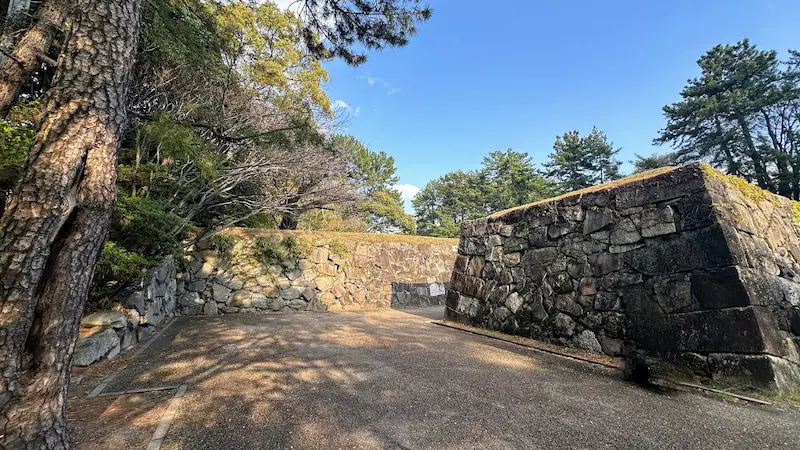
🏛 Overview
Situated on the eastern side of the Ofukemaru area, the Shiogura Gate Ruins mark the former entrance to a small defensive enclosure once known as Shiogura-kamae. This gate was designed in the masugata-mon style—a box-like defensive structure—and served as the primary entrance to the salt storage area, from which it derived its name.
Although the gate itself no longer stands, the remaining stone walls still vividly evoke its historical role within the castle’s defensive network. Impressively, these stones are inscribed with the crests and markings of the daimyo who contributed to the castle’s construction—making this a point of great historical significance.
🗺 Address
1-1 Honmaru, Naka Ward, Nagoya, Aichi Prefecture (inside Ofukemaru)
🚶 Access
Approx. 1-minute walk (30m) from Akazu no Mon (Fumeimon)
⏳ Suggested Visit Duration
- Quick Stop: Approx. 3 minutes
- In-depth Tour: Approx. 15 minutes
📍 Highlights
- Remnants of the Gate: Observe the original masugata stone layout, a showcasing Edo-era defensive engineering.
- Inscriptions in Stone: Spot the engraved seals left by feudal lords—an exciting challenge for history buffs.
- Seasonal Appeal: In spring, cherry blossoms bloom around the ruins, offering a picturesque blend of nature and history.
📌 Trivia
- Historical Function: This gate facilitated the movement of stored provisions, particularly salt, within the castle grounds.
- Hidden Detail: It’s also a popular viewing point for spotting daimyo marks on the stones supporting the Tenshukaku.
- Famous Connections: Built by feudal lords under the command of Tokugawa Ieyasu, their legacy remains carved in stone.
Tenshukaku Foundation Stones
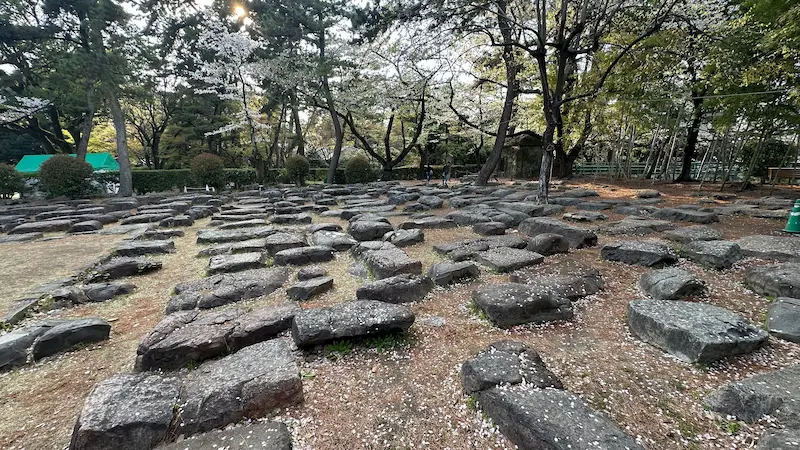
🏛 Overview
The Tenshukaku Foundation Stones once supported the grand main keep of Nagoya Castle. Following the destruction of the keep during the 1945 air raids, these foundation stones were relocated to the eastern side of Ofukemaru and preserved as a memorial.
The stones still bear burn marks from the firebombing, serving as stark, tangible evidence of wartime devastation. The original Tenshukaku was built in just three months by master castle builder Kato Kiyomasa, who oversaw the construction of the keep’s stone base between 1610 and 1612.
Today, the stones are arranged to reflect their original placement, allowing visitors to appreciate the immense scale and structure of the former keep.
🗺 Address
1-1 Honmaru, Naka Ward, Nagoya, Aichi Prefecture (inside Ofukemaru)
🚶 Access
Approx. 1-minute walk (20m) from Shiogura Gate Ruins
⏳ Suggested Visit Duration
- Quick Stop: Approx. 3 minutes
- In-depth Tour: Approx. 15 minutes
📍 Highlights
- Stone Layout: The foundation stones are neatly arranged to reflect the original structure, allowing you to envision the architectural footprint of the main keep.
- Scorched Marks: Evidence of wartime destruction can still be seen on the stones, offering a solemn reminder of the past.
- Seasonal Appeal: Cherry blossoms in spring add a touch of beauty to this somber historical site.
📌 Trivia
- Historical Relocation: These stones were moved here after WWII and reassembled to preserve their original layout.
- Hidden Legacy: Some stones still retain burn marks from the bombing—an enduring testament to their historical significance.
- Famous Builder: The stone base of the keep was built by Kato Kiyomasa, showcasing his legendary skill in castle construction.
Sekkanshiki Sekishitsu: The Stone Coffin Chamber
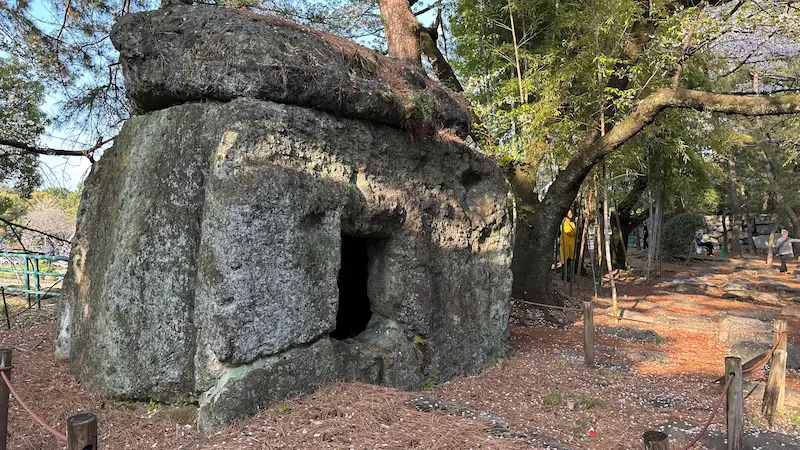
🏛 Overview
The Sekkanshiki Sekishitsu (stone coffin-style chamber) is a burial facility dating back to the late Kofun period, approximately 1,400 years ago, now quietly situated within the Ofukemaru Tea Garden in the northwestern grounds of Nagoya Castle. However, it’s important to note that this stone chamber did not originally stand at this location prior to the construction of Nagoya Castle. It was relocated and preserved here during the early Showa period, having originally been part of the Danbara Kofun in Matsue City, Shimane Prefecture.
As such, the chamber has no direct connection to Tokugawa Ieyasu or the Edo-period history of Nagoya Castle. Instead, it is preserved as an archaeological exhibit showcasing the cultural heritage of ancient Izumo, and is part of the castle’s broader cultural display.
🗺 Address:
1-1 Honmaru, Naka Ward, Nagoya, Aichi Prefecture
🚶 Access:
Approximately a 1-minute walk (about 20 meters) from the Tenshukaku Foundation Stones.
⏳ Estimated Visit Duration:
- Quick look: Around 5–10 minutes
- For archaeology enthusiasts: Approximately 15–20 minutes
📍 Highlights:
🔹 Stone Coffin-Style Chamber: This Kofun-era burial structure measures approximately 2.5 meters wide, 1.8 meters deep, and 2 meters high. It’s built using a combination of large stones, showcasing impressive ancient stonework.
🔹 Izumo-Style Design: A representative example of burial chambers commonly found in the San’in region, this chamber offers insights into the funerary culture of ancient Japan.
🔹 Contrast with the Tea Garden: The juxtaposition of the ancient burial structure and the refined Edo-period tea garden of Nagoya Castle creates a fascinating cultural contrast.
📌 Trivia:
- A Hidden Historical Journey: This chamber was purchased in 1936 (Showa 11) by a Nagoya-based antiquities dealer, Chogido Hasegawa, and later donated to Nagoya City in 1949 (Showa 24). It was relocated from the Danbara Kofun in Shimane Prefecture.
- A Little-Known Feature: It is the only Kofun-era structure within Nagoya Castle, though visitors should keep in mind that it is a relocated structure and not native to the site.
- No Connection to Famous Figures: This structure has no ties to Tokugawa Ieyasu or the Owari Tokugawa family, and it played no role in the original construction of Nagoya Castle (which took place between 1609 and 1612).
ℹ️ Additional Info:
English translation of a sign originally displayed only in Japanese.
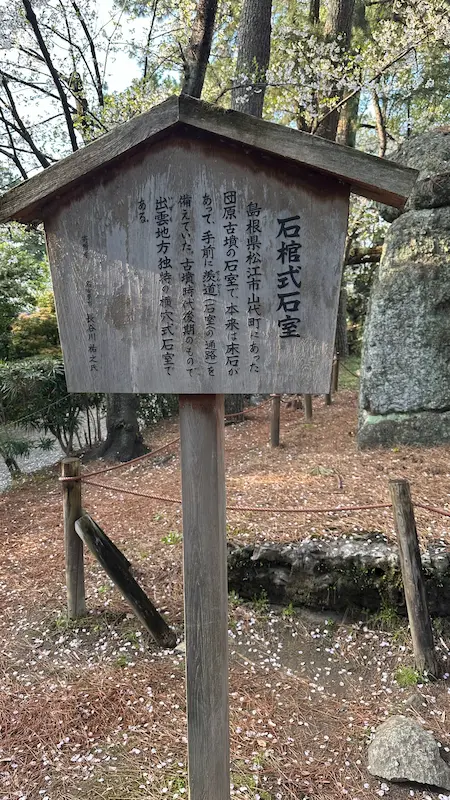
Sarcophagus-Style Stone Chamber
This stone chamber was originally part of the Tawara Kofun burial mound located in Yamashiro Town, Matsue City, Shimane Prefecture. In its original form, the chamber featured a floor stone and an antechamber (known as a sendō)—a passage leading into the burial chamber itself. Dating back to the late Kofun period, this is a distinctive example of a horizontal stone chamber burial unique to the Izumo region.
Donated by: Mr. Hiroyuki Hasegawa
Tea Houses
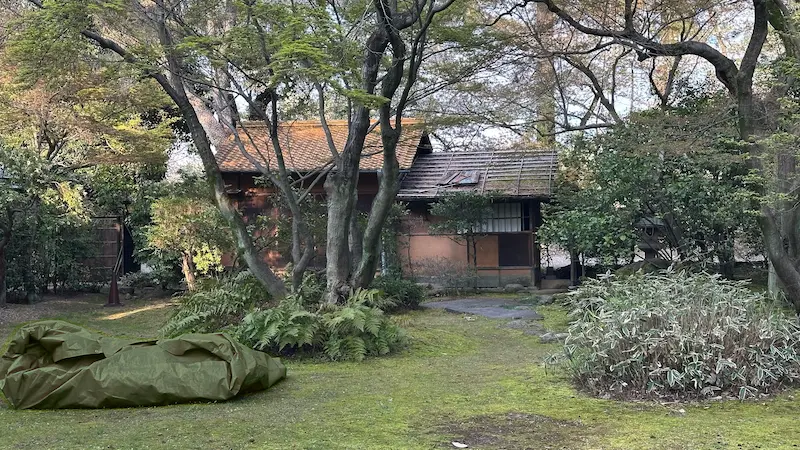
🏛 Overview
Within the gardens of Ofukemaru is a 2,000-square-meter space that is home to four distinct tea houses, each with its own architectural style and historical backstory. These structures, though not usually open to the public, are used during special occasions such as tea ceremonies and weddings—preserving the spirit of Nagoya’s rich tea culture.
🫖 Featured Tea Houses
- Sarumen Tea House: Named for a floor pillar whose grain resembles a monkey’s face—referencing Oda Nobunaga’s famous remark about Toyotomi Hideyoshi.
- Bōgaku Tea House: Though its origins are unclear, it is one of the notable tea spaces within the castle grounds.
- Yūin Tea House: A faithful reproduction of the original tea room built by Sen Sōtan, grandson of tea master Sen Rikyū.
- Oribe Hall: Dedicated to tea master Furuta Oribe, this structure was built in 1955 to honor his legacy.
🗺 Address
1-1 Honmaru, Naka Ward, Nagoya, Aichi Prefecture (inside Ofukemaru)
🚶 Access
Approx. 1-minute walk (50m) from the Sekkanshiki Sekishitsu: The Stone Coffin Chamber
⏳ Suggested Visit Duration
- Quick Stop: Approx. 3 minutes (for a quick stroll and exterior viewing)
- In-depth Tour: Approx. 15 minutes (for observing each structure and photography)
📍 Highlights
- Architectural Aesthetics: Enjoy the refined designs and traditional craftsmanship of each tea house.
- Serene Gardens: Wander through landscaped grounds that offer a calming escape and seasonal visual delights.
- Seasonal Appeal: Spring cherry blossoms and autumn leaves enhance the harmony of nature and architecture.
📌 Trivia
- Unexpected History: The Sarumen Tea House takes its name from a floor pillar resembling a monkey’s face—a nod to Hideyoshi’s nickname.
- Little-Known Fact: These tea houses are generally closed to the public but can be accessed during exclusive events.
- Cultural Significance: The Yūin Tea House links directly to Sen Rikyū’s lineage, marking its importance in the world of Japanese tea ceremony.



comment